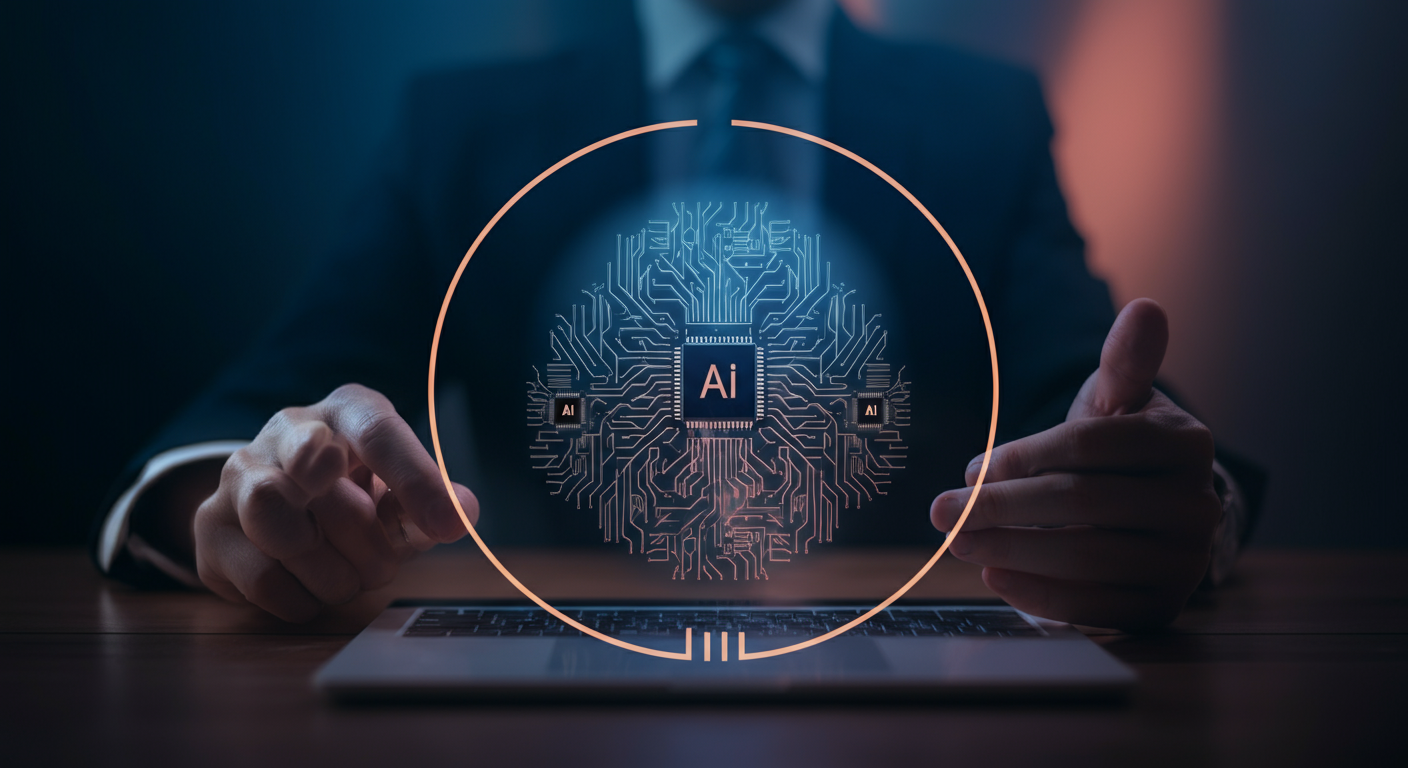AI Retail Analytics: Transforming Data into Competitive Advantage

The AI-Powered Retail Revolution: Why Analytics is No Longer Optional
AI is rapidly transforming retail, offering unprecedented opportunities to personalize customer experiences, boost operational efficiency, and make smarter strategic decisions. It's no longer a question of if retailers should embrace AI, but how to leverage its power most effectively.
From Traditional to AI-Driven Insights
Traditional retail analytics primarily focused on historical sales data and basic customer segmentation. AI takes this several steps further by:- Predictive Analytics: Forecasting future demand, optimizing inventory levels, and identifying emerging trends.
- Personalized Recommendations: Tailoring product suggestions and marketing campaigns to individual customer preferences.
- Real-time Optimization: Adjusting pricing, promotions, and staffing based on current conditions.
Quantifiable Benefits & ROI of AI Retail Analytics
The ROI of AI retail analytics is substantial, with companies reporting:- Increased Revenue: Up to a 15% increase through personalized recommendations and targeted marketing.
- Reduced Costs: Streamlining operations and minimizing waste, particularly in supply chain management.
- Improved Customer Satisfaction: Creating seamless and personalized shopping experiences.
Real-World Examples
Leading retailers are already reaping the rewards:- Zara: Uses AI to analyze sales data and social media trends, enabling them to quickly adapt their designs and production to meet consumer demand.
- Amazon: Employs sophisticated AI algorithms to personalize product recommendations, optimize pricing, and manage its vast logistics network.
Decoding Customer Behavior: AI's Role in Understanding the Modern Shopper
AI retail analytics is revolutionizing how businesses interact with customers.
Data-Driven Insights
AI transforms raw data from various customer touchpoints into actionable insights.- Online: AI analyzes website browsing behavior, purchase history, and social media activity.
- In-Store: AI uses sensors, cameras, and point-of-sale data to track foot traffic, dwell times, and product interactions.
- Mobile: AI mines data from mobile apps to understand location-based behavior, app usage patterns, and mobile purchases.
AI-Powered Segmentation
AI powered customer segmentation enables businesses to group customers based on shared characteristics.- Personalized shopping experiences are created through AI powered customer segmentation.
- For example, an AI algorithm might identify a segment of eco-conscious customers and tailor product recommendations towards sustainable goods.
- Using ChatGPT, retailers can develop personalized marketing messages for each segment.
Predicting Demand
Predictive analytics, powered by AI, forecasts demand and optimizes inventory.- Reduces stockouts and waste by optimizing inventory levels based on predictive models.
- Forecasts future demand trends using historical data, seasonality, and external factors like weather and economic indicators.
- Pricing Intelligence AI tools can dynamically adjust prices to maximize revenue based on predicted demand.
Retail Sentiment Analysis Tools
Retail sentiment analysis tools use natural language processing (NLP) to understand customer emotions and feedback.Sentiment analysis is the automated process of identifying the emotional tone behind a piece of text.
- Analyzing customer reviews, social media comments, and survey responses to gauge customer satisfaction.
- NLP algorithms identify key themes and sentiments expressed by customers.
- For example, retail sentiment analysis tools help retailers identify products generating negative feedback and take corrective actions.
Case Study: Personalized Product Recommendations
Imagine a clothing retailer using AI to analyze customer purchase history, browsing behavior, and demographic data. The AI identifies that customers who have previously bought hiking boots are also likely to purchase camping gear. As a result, the retailer can increase sales by sending personalized email recommendations for tents, sleeping bags, and other related products to these customers.
AI is changing retail by turning data into a powerful competitive advantage, ultimately leading to happier customers and more profitable businesses.
Utilizing AI retail analytics offers a powerful lens to understand the nuances of shopper behavior and transform in-store experiences.
Understanding Shopper Movement
AI-powered video analytics can track customer movement within a store, providing insights previously unavailable. Retailers can now leverage advanced Heatmap Analytics to optimize store layouts by visually representing high-traffic areas, revealing popular pathways, and identifying underutilized zones. This data empowers informed decisions about product placement, promotional displays, and overall store flow.
AI in retail offers a clear competitive advantage – it's about understanding customer behavior to create a better, more profitable shopping experience.
Planogram and Shelf Optimization
AI drives efficiency beyond just traffic flow; it also optimizes product presentation.
- Planogram Optimization: AI analyzes sales data, shopper behavior, and visual appeal to determine optimal shelf arrangements, ensuring that high-demand products are easily accessible and visually appealing.
- Maximizing Visibility: By identifying products that are often overlooked, AI-driven planograms enhance visibility and boost sales.
Adapting to a New Normal
Post-pandemic, retailers must adapt their store layouts to prioritize social distancing and safety. AI assists with:
- Monitoring Social Distancing: Video analytics can monitor and ensure customers adhere to social distancing guidelines, providing alerts when crowding occurs.
- Optimized Traffic Flow: AI-driven simulations can test and optimize store layouts to minimize congestion and maximize customer safety, creating a comfortable shopping environment and increased customer confidence.
AI is key to turning raw retail data into actionable insights, leading to enhanced customer experiences and improved ROI.
AI is revolutionizing loss prevention and security measures in retail, providing businesses with unprecedented levels of vigilance.
AI-Powered Video Surveillance
AI enhances traditional video surveillance by analyzing footage in real-time to identify theft, fraud, and other suspicious activities. For instance, an AI powered anti theft system retail can detect unusual patterns, like someone lingering near a display for an extended time, or quickly concealing merchandise. These systems, unlike human monitors, never get tired, maintaining constant vigilance."AI-driven video analytics provides a crucial layer of security that goes beyond the capabilities of human surveillance alone."
Predictive Analytics for Risk Prevention
Predictive analytics takes a proactive approach, identifying potential security risks before incidents occur. Using algorithms that analyze historical data, AI can pinpoint high-risk areas or times of day when theft is more likely. This allows retailers to strategically allocate resources, like increasing security staff during peak hours, preventing incidents before they happen.Facial Recognition and Inventory Management

Facial recognition technology, while requiring careful ethical considerations and legal compliance, helps identify known shoplifters as they enter the store. Furthermore, AI-driven inventory management systems can detect discrepancies and prevent shrinkage, pinpointing when and where inventory loss occurs.
- These systems use advanced algorithms to track inventory levels and detect anomalies.
- By continuously monitoring stock, they can quickly identify potential theft or errors, enabling retailers to take corrective action promptly.
Transforming data into a competitive edge is now possible with AI retail analytics, enabling businesses to make smarter, faster decisions.
Implementing AI Retail Analytics: A Step-by-Step Guide
Integrating AI into your retail strategy requires a structured approach:
- Assessment: Begin with a thorough evaluation of your current data infrastructure, identifying key performance indicators (KPIs) and areas for improvement.
- Tool Selection: Choosing the appropriate AI tools is crucial. For example, pricing intelligence tools can optimize pricing strategies.
- Integration: Implementing AI solutions should be done gradually, starting with pilot projects to validate their effectiveness.
- Training: Invest in training programs to equip your team with the skills needed to interpret and utilize AI-driven insights.
Choosing the Right AI Tools and Platforms
Selecting the right tools is paramount for successful implementation:
- Data Analytics Platforms: These platforms offer advanced capabilities for analyzing customer behavior, sales trends, and inventory management.
- Machine Learning Models: Tailor models to your specific needs, such as predicting demand or personalizing recommendations.
- Considerations: Factor in scalability, integration capabilities, and the specific requirements of your retail environment.
Data Privacy and Security
Navigating data privacy is essential:
- Compliance: Ensure adherence to regulations like GDPR and CCPA through data anonymization and secure data handling practices.
- Best Practices: For additional insights, explore resources on retail data privacy best practices. This will help you ensure you have the correct protocols for cybersecurity threats.
Building a Skilled Team
A capable team is the backbone of any AI initiative:
- Hiring: Recruit data scientists, AI engineers, and retail analysts with expertise in machine learning and data visualization.
- Collaboration: Foster a collaborative environment where IT, marketing, and operations teams can work together to leverage AI insights effectively.
Overcoming Common Challenges
Address potential roadblocks head-on:
- Data Silos: Break down silos by creating a centralized data repository for seamless access and analysis.
- Lack of Expertise: Invest in training programs to upskill your team and bridge the knowledge gap.
- Resistance to Change: Communicate the benefits of AI analytics to foster buy-in and overcome resistance.
Here’s how AI retail analytics transforms data into a powerful competitive advantage.
The Rise of Real-Time Insights
Edge computing is revolutionizing retail by enabling real-time analytics. Instead of sending data to a central server, processing happens on-site, in the store. This allows for faster decision-making, such as adjusting inventory based on immediate demand. For example, if pricing intelligence tools detect a competitor's price change, immediate adjustments can be made.Synergy with IoT and Blockchain
The integration of AI with other technologies like IoT and blockchain provides even deeper insights. IoT devices, such as smart shelves, track inventory levels and customer interactions. Blockchain enhances transparency and security in the supply chain. Together with AI, these technologies offer a holistic view of retail operations. This combined use of AI and IoT in retail enhances operational efficiency and customer experiences.Augmented and Virtual Reality in Retail
Augmented reality (AR) and virtual reality (VR) are enhancing customer experiences. Imagine customers using AR apps to visualize furniture in their homes before making a purchase, or using VR to explore a virtual store.AR and VR personalize the shopping experience, increasing engagement and sales.
Personalized Advertising and Marketing
AI's impact on personalized advertising is substantial. AI algorithms analyze customer data to create targeted marketing campaigns. This can lead to higher conversion rates and increased customer loyalty. Marketing teams can leverage marketing automation tools to execute these personalized campaigns efficiently.Future Predictions
The future of retail analytics will see AI playing an even more central role. Predictions include increased automation, hyper-personalization, and predictive analytics that anticipate future trends with increasing accuracy. These AI-driven strategies will help retailers optimize operations, enhance customer experiences, and gain a competitive edge.AI retail analytics transforms raw data into actionable insights, offering a competitive edge.
Measuring the Impact of AI: The Role of KPIs
To understand the true value of AI in retail, businesses need to track Key Performance Indicators (KPIs) rigorously. These metrics provide tangible evidence of improvements driven by AI, and help assess the AI retail analytics ROI.Key KPIs to Watch

- Customer Engagement:
- Website Conversion Rate: Track how effectively your website turns visitors into buyers. For example, AI-powered recommendations can boost this.
- Customer Lifetime Value (CLTV): Understand the long-term revenue generated by each customer. AI can personalize offers and improve customer retention, positively impacting CLTV.
- Sales Growth:
- Average Transaction Value: AI algorithms can identify opportunities for upselling and cross-selling, leading to increased transaction sizes.
- Sales per Square Foot: A traditional retail metric enhanced by AI's ability to optimize product placement and promotional strategies.
- Operational Efficiency:
- Inventory Turnover Rate: AI helps forecast demand and optimize stock levels, reducing waste and storage costs. For instance, pricing intelligence tools are valuable here.
- Supply Chain Costs: AI can identify bottlenecks and inefficiencies, streamlining logistics and reducing overall expenses.
- Loss Prevention:
- Shrinkage Rate: AI-powered video analytics can detect theft and fraud, helping retailers minimize losses.
Visualizing Progress
Dashboards and reporting tools are essential to visualize your retail analytics KPIs examples and track progress over time. Look for solutions that provide real-time insights and customizable reporting options.AI's transformative power in retail hinges on a clear understanding and measurement of success. By strategically tracking KPIs, retailers can ensure they're not just implementing AI, but driving tangible business outcomes. Next, we will review building strong data foundations for accurate AI.
Keywords
AI retail analytics, retail analytics, artificial intelligence retail, customer behavior analysis, store optimization, loss prevention, AI in retail, retail data analytics, predictive analytics retail, AI powered customer experience, retail intelligence, in-store analytics, retail marketing analytics, AI driven inventory management
Hashtags
#AIRetail #RetailAnalytics #AIinBusiness #DataDrivenRetail #RetailTech
Recommended AI tools

Your AI assistant for conversation, research, and productivity—now with apps and advanced voice features.

Bring your ideas to life: create realistic videos from text, images, or video with AI-powered Sora.

Your everyday Google AI assistant for creativity, research, and productivity

Accurate answers, powered by AI.

Open-weight, efficient AI models for advanced reasoning and research.

Generate on-brand AI images from text, sketches, or photos—fast, realistic, and ready for commercial use.
About the Author

Written by
Regina Lee
Regina Lee is a business economics expert and passionate AI enthusiast who bridges the gap between cutting-edge AI technology and practical business applications. With a background in economics and strategic consulting, she analyzes how AI tools transform industries, drive efficiency, and create competitive advantages. At Best AI Tools, Regina delivers in-depth analyses of AI's economic impact, ROI considerations, and strategic implementation insights for business leaders and decision-makers.
More from Regina

